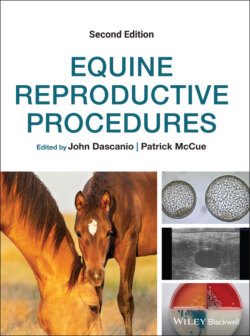Читать книгу Equine Reproductive Procedures - Группа авторов - Страница 64
G‐banding
ОглавлениеThe method produces distinct banding patterns characteristic to individual horse chromosomes (Figures 22.2 and 22.3) and is used for refined chromosome analysis. It allows chromosome identification, arranging them into a karyotype following the international nomenclature (Bowling et al. 1997), and detecting numeric and structural abnormalities. There are many modifications to the original G‐banding method (Seabright 1971). The following procedure is used for G‐banding at the Molecular Cytogenetics Laboratory at Texas A&M University.
Figure 22.2 A G‐banded metaphase spread of a normal male horse; magnification 1,000×.
Figure 22.3 G‐banded chromosomes of a normal male horse arranged into a karyotype.
Bake slides on a hot plate at 70°C (158°F) for 10–20 minutes and allow to cool.
Dip the slides in HBSS for 1 minute.
Treat the slides with 0.125% trypsin working solution in HBSS for 1–5 seconds.
Dip the slides in HBSS containing 2% FBS for 1 minute.
Dip the slides in Gurr buffer for 1 minute.
Stain the slides in 4% Giemsa in Gurr buffer for 5 minutes and air‐dry.
Check the quality of chromosomes and G‐banding under a microscope and adjust the time of trypsin treatment and Giemsa staining if necessary.
